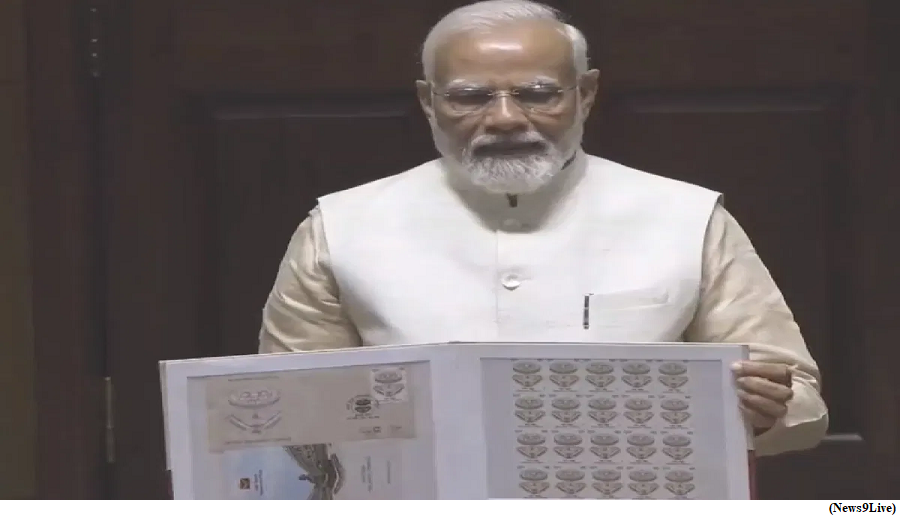A Foucault pendulum swings inside the new Parliament (GS Paper 3, Science and Technology)

Why in news?
- One of the features of the new Parliament building in New Delhi, is a Foucault pendulum suspended from its ‘Constitutional Gallery’ area.
- It has been designed and installed by the National Council of Science Museums (NCSM), Kolkata.
What is Foucault pendulum?
- The Foucault pendulum is named for Léon Foucault (1819-1868), the French physicist who devised the apparatus in the 19th century.
- It is a deceptively simple device used to illustrate the earth’s rotation. At the time Foucault set up the first public display of the pendulum, the earth’s rotation was a well- established fact.
- His achievement, instead, was to provide a proof that didn’t involve intricate astronomical observations and calculations.
- The pendulum consists of a bob suspended at the end of a long, strong wire from a fixed point in the ceiling. As the pendulum swings, the imaginary surface across which the wire and the bob swipe is called the plane of the swing.
- If the pendulum is installed at the North Pole, it will basically be swinging as the earth rotates ‘below’. But someone standing on the earth’s surface doesn’t notice the planet’s rotation (without looking up at the sky from time to time); instead, to them, the plane of the swing will seem to rotate by a full circle as the earth completes one rotation.
- If the pendulum is installed over the equator, the plane won’t appear to shift at all because it will be rotating along with the earth. On any other latitude, the plane will shift through 360 degrees in “one sidereal day divided by the sine of the latitude of its location”.
Installation at NCSM:
- A Foucault pendulum is not a simple matter of setting up a pendulum with large parts. It must be designed, installed, and set swinging in such a way that the bob’s motion is influenced to the extent possible only by gravity.
- In 1991, the then-new Inter-University Centre for Astronomy and Astrophysics, Pune, commissioned the country’s first Foucault pendulum for public display from the NCSM. After several studies and failed tests, the NCSM installed the set-up in 1993.
PM Modi releases Rs 75 coin on new Parliament inauguration day
(GS Paper 3, Science and Technology)
Why in news?
- To mark the inauguration of the new Parliament building, Prime Minister recently released a commemorative coin of Rs 75 denomination.
- India has been issuing commemorative coins since the 1960s for several reasons such as paying homage to notable personalities, spreading awareness about government schemes, or remembering key historic events.

Key features:
What are the features of the new Rs 75 commemorative coin?
- The latest Rs 75 coin is circular in shape with a diameter of 44mm.
- The composition of the coin is of a quaternary alloy — 50 per cent silver, 40 per cent copper, 5 per cent nickel and 5 per cent zinc.
- The face of the coin shall bear the Lion Capitol of Ashoka Pillar in the centre, with the legend Satyameva Jayate inscribed below, flanked on the left periphery with the word Bharat in Devnagri script and on the right periphery the word “INDIA” in English.
- The other side of the coin displays an image of the new parliament building.
- The inscription “Sansad Sankul” is written in Devanagari script on the upper periphery while the words “Parliament Complex” in English on the lower periphery of the coin.
Who has the power to design and mint coins?
- The Coinage Act, 2011 gives the central government the power to design and mint coins in various denominations. In the case of coins, the role of the RBI is limited to the distribution of coins that are supplied by the central government.
- In 2017, the government issued commemorative coins to pay homage to Indian actor and politician Late MG Ramachandran and Carnatic singer MS Subbalakshmi.
- The decision was taken after “the request was placed by Sri Shanmukhananda Fine Arts & Sangeetha Sabha for the MS Subbalakshmi commemorative coins and by the Tamil Nadu government for the MG Ramachandran commemorative coins.
- All coins are minted in the four mints owned by the Government of India in Mumbai, Hyderabad, Kolkata and Noida.
When was the first time India issued a commemorative coin?
- The country released its first commemorative coin in 1964 in honour of Jawaharlal Nehru, who had passed away that year.



